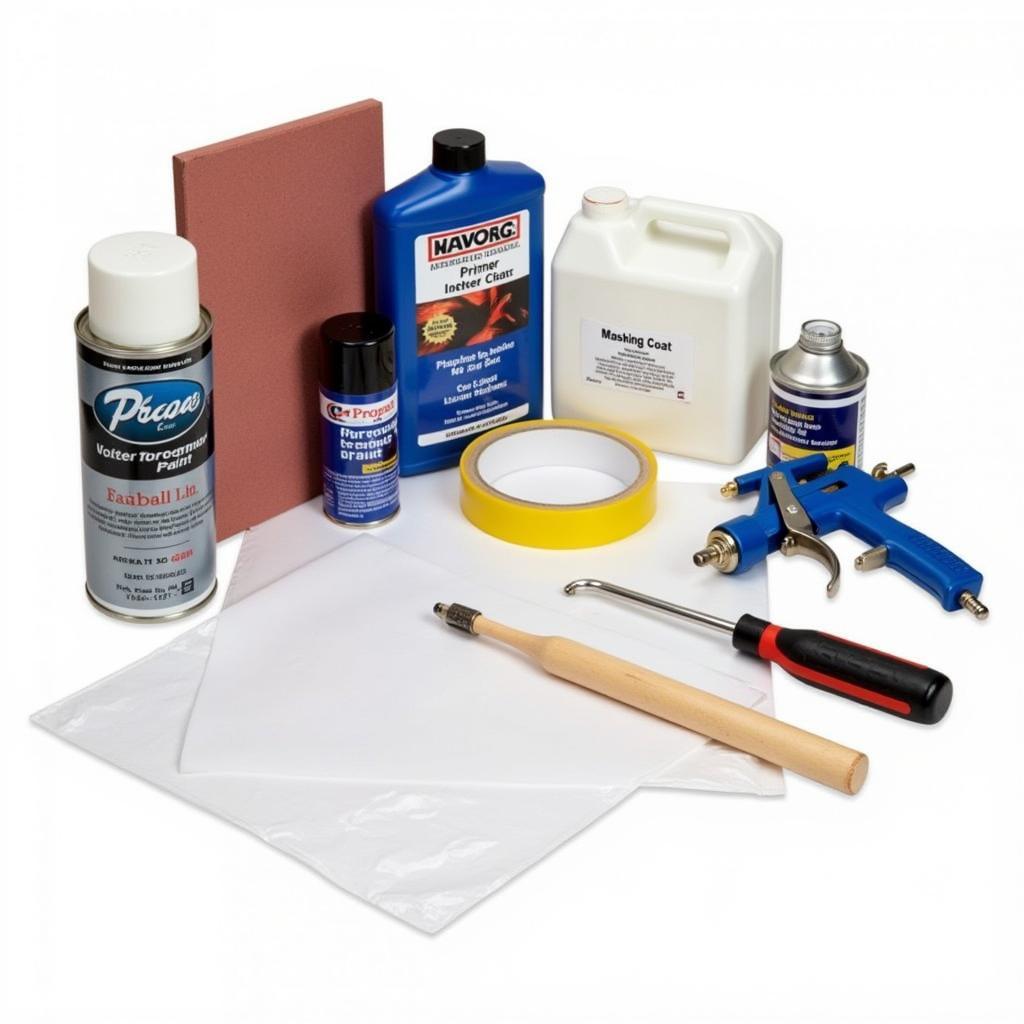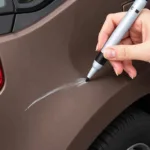Missing paint on your car isn’t just an eyesore; it’s an open invitation to rust and corrosion. Learning how to repair missing paint on your car is a valuable skill that can save you money and keep your vehicle looking its best. This guide will provide a step-by-step process, from assessing the damage to applying the final coat, empowering you to tackle this common car problem.
Assessing the Damage: Know Your Enemy
Before you grab your sandpaper, take a close look at the damaged area. How deep is the scratch? Is it just a superficial clear coat scratch, or has it gone down to the primer or bare metal? The extent of the damage will dictate the repair process. A small chip might only require touch-up paint, while larger areas might necessitate sanding, priming, and painting. Don’t underestimate the importance of this step, as proper assessment is crucial for achieving a professional-looking result.
Gathering Your Supplies: The Right Tools for the Job
Having the right tools and materials on hand will make the repair process smoother and more efficient. For minor paint chips, you’ll need touch-up paint, a fine-tipped brush, rubbing compound, and polishing cloth. For more extensive damage, gather sandpaper (various grits), primer, paint, clear coat, masking tape, plastic sheeting, and a spray gun or aerosol cans. Investing in quality materials will contribute to a more durable and aesthetically pleasing finish.
Preparing the Area: A Smooth Foundation for Success
Clean the damaged area thoroughly with soap and water, then dry it completely. If rust is present, use a wire brush or sandpaper to remove it. For larger repairs, mask off the surrounding areas with masking tape and plastic sheeting to protect them from overspray. Sand the damaged area with progressively finer grits of sandpaper until the surface is smooth and even. This creates a proper surface for the primer and paint to adhere to.
Priming (If Necessary): Building a Solid Base
If the damage has reached the bare metal or primer, apply a thin, even coat of automotive primer. Allow the primer to dry completely according to the manufacturer’s instructions. This step ensures proper adhesion and prevents future rust formation. Priming also helps the color coat achieve a uniform finish.
Applying the Paint: The Art of Matching and Blending
Whether you’re using touch-up paint or a spray gun, the key is to apply thin, even coats. For touch-up paint, use a fine-tipped brush to dab the paint onto the chip, building up the layers until it’s level with the surrounding surface. For larger repairs, use a spray gun or aerosol can, applying multiple light coats with overlapping strokes. Allow each coat to dry before applying the next. This prevents runs and drips and ensures a smooth, even finish.
Applying Clear Coat (If Necessary): The Protective Shield
If your car has a clear coat finish, apply a few thin, even coats of clear coat after the color coat has dried. This adds a layer of protection against UV rays, scratches, and other environmental factors, preserving the paint job’s shine and durability.
Wet Sanding and Polishing: The Finishing Touch
Once the clear coat has dried completely (usually 24-48 hours), wet sand the repaired area with very fine grit sandpaper (2000-3000 grit) to remove any imperfections. Then, use rubbing compound and a polishing cloth to restore the shine and blend the repaired area seamlessly with the surrounding paint.
Conclusion: A Job Well Done
Repairing missing paint on your car can seem daunting, but by following these steps, you can achieve professional-looking results and protect your vehicle from further damage. Remember, patience and attention to detail are key. By taking the time to properly assess, prepare, and apply the paint, you can restore your car’s appearance and prevent rust and corrosion. So, grab your tools and give your car the TLC it deserves!
FAQ
- What type of paint should I use for touch-ups? Use touch-up paint specifically designed for your car’s make, model, and year to ensure a perfect color match.
- Can I repair paint damage in direct sunlight? No, direct sunlight can cause the paint to dry too quickly, leading to an uneven finish.
- How long should I wait between coats of paint? Follow the manufacturer’s instructions for drying times, which typically range from 15 to 30 minutes.
- Do I need to apply a clear coat? If your car originally had a clear coat finish, you should apply a clear coat to protect the repaired area.
- How can I prevent future paint chips? Waxing your car regularly, parking in covered areas, and avoiding driving on gravel roads can help minimize paint chips.
- What if the damage is too extensive for DIY repair? For large or complex repairs, it’s best to consult a professional auto body shop.
- How can I match my car’s paint color perfectly? Check your car’s owner’s manual or the sticker inside the driver’s side doorjamb for the paint code.
For further assistance, please contact us via WhatsApp: +1(641)206-8880 or Email: [email protected]. Our customer service team is available 24/7.


